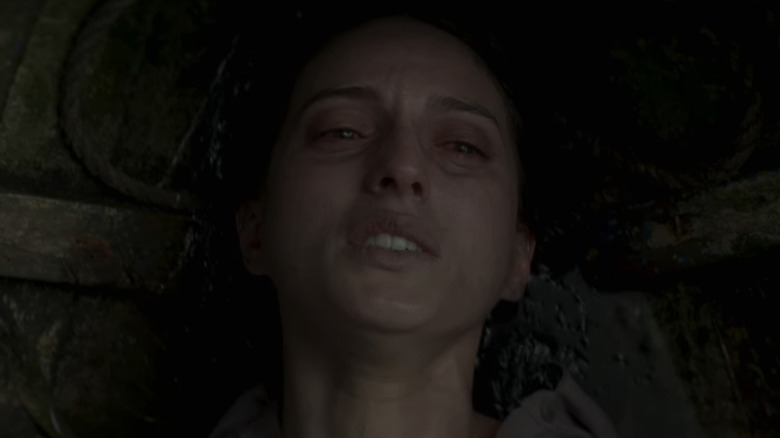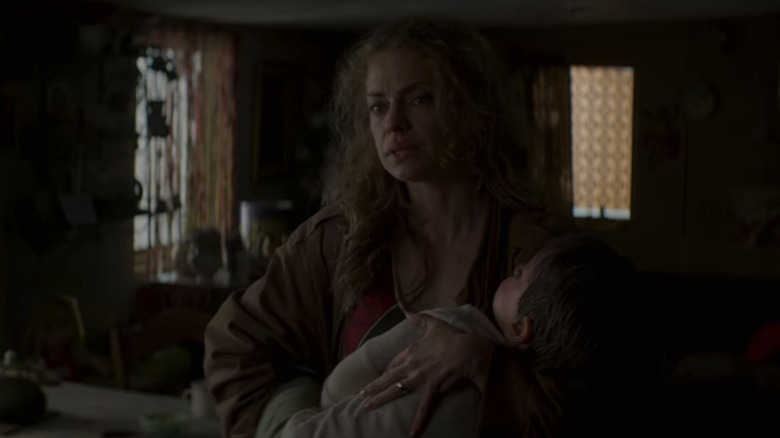The Ending Of Fever Dream Explained
Few things are more unsettling than unexplained illnesses, hidden threats, and impending harm to children — and the newest Netflix psychological horror is packed full of all three. "Fever Dream," based on the novel of the same name (though the original title better translates to "Rescue Distance"), follows a mother named Amanda (María Valverde) as she narrates what happened after traveling to the countryside for a vacation with her young daughter Nina (Guillermina Sorribes Liotta).
Amanda describes the events to David (Marcelo Michinaux), the mysterious young boy whose mother Carola (Dolores Fonzi) befriends Amanda once she arrives in the small town, and warns Amanda about the strange occurrences that have recently plagued the village. Since "Fever Dream" takes place in Amanda's memory and is related to the viewer through her own incomplete narration, it can be difficult to discern the true reality of the matter at hand. No surprise, then, that the ending could benefit from a little explanation.
Let's take a look at the final scenes of "Fever Dream," and what it all means.
The hidden threat in Fever Dream
By the end of "Fever Dream," we realize that Amanda succumbed to her illness. The cause of her infection is the same thing that made David sick in the past, and also threatens Nina's health — the toxic pesticides and chemicals that are constantly used on crops in the small town. Amanda and Nina spent most of their time frolicking in fields, laying in grass, and swimming in local ponds, without realizing that all of the land around them was contaminated by deadly toxins.
Nina is also in a fragile state at the end of the film, and while Amanda lays on her deathbed, Carola informs her that she's taking Nina to the Green House where David was once cured through soul transmigration. The epilogue of the film shows David's father Omar (German Palacios) and Nina's father Marco (Guillermo Pfening) discussing how their children have changed after the events that resulted in Amanda's death. Our final glimpse of David is a sad one, a scene in which he clutches for Nina's favorite stuffed animal — and it looks like, perhaps, part of Nina's soul was transferred into David's body.
In this way, the final moments of "Fever Dream" are as opaque as the rest of Amanda's telling, and in many ways that's the point. The story the audience experiences is itself a kind of fever dream.
Fever Dream is about motherhood
Throughout the film, Amanda refers to the "rescue distance" between her and Nina, which helps her to discern if her daughter is close enough to be rescued should she come into trouble. As we eventually learn, however, Nina becomes critically ill after being exposed to chemical toxins in the small town, which Amanda didn't factor in as a threat until it was too late. Amanda's obsession with calculating the rescue distance to Nina ends up being a useless exercise, as David tries to get Amanda to realize she missed the most important signs of danger the whole time.
Carola also represents another aspect of motherhood: the guilt a mother experiences when her child is harmed. After David's soul was split in two in an attempt to save his life, Carola felt he was a completely different person — though it isn't clear if he actually did change, or if Carola's perception of him is what changed. She could have been overcome with guilt for not preventing David's illness, and had trouble facing her role in his situation as well as coming to terms with the aftermath of his illness.
Overall, "Fever Dream" works as a reminder of the pressure and guilt that comes with mothering, and the different ways that it can impact you mentally — especially when things go wrong. As noted above, the book's original Spanish title is "Distancia de rescate," suggesting this reading of the film as a meditation on the boundless obligation of motherhood and the terrible impact of unchecked guilt is actually a more important takeaway than untangling every twist and turn of the intentionally opaque plot.
Fever Dream was inspired by real environmental issues
As confusing and eerie as "Fever Dream" gets, the inspiration behind it is just as disturbing. Samanta Schweblin, who wrote the novel that the film is based on and co-wrote the film's screenplay, spoke to Literary Hub about the environmental issues that served as inspiration for the story — specifically, harmful pesticides used in the agricultural industry.
"This story could be set anywhere," Schweblin told LitHub. "In fact, the first time I heard about pesticides and their terrible consequences was through a documentary about this subject in France. But, mainly because of corruption, Latin America has the worst agrochemical regulations and agreements. And Argentina, in particular, is one of the biggest importers of soya — one of the products more related with pesticides. We spread this soya all over the world; it is the base of a lot of our food."
While the truth behind "Fever Dream" is disconcerting in itself, the film is imbued with just enough supernatural elements to make it feel otherworldly. This sense of the uncanny, which only truly takes over at the very end of the film, has become a hallmark device of "CliFi" storytelling — a subgenre of science fiction that takes on the weird realities of environmental degradation and the slow apocalypse of climate change (via Electric Lit). In this way, Schweblin's novel and the adapted film leverage the tropes of imaginative genre to tell a story that is all-too real.



